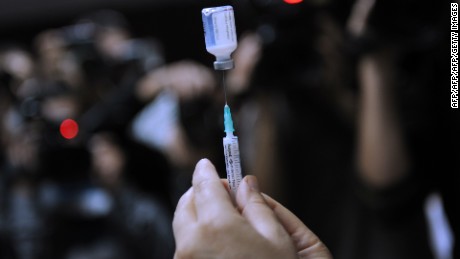Story highlights
- The form of influenza mainly infects birds
- Certain strains have mutated to transmit from birds to humans
(CNN)If an avian influenza pandemic ever hit the United States, there's only one dependable manufacturer in the country capable of making a vaccine, a government watchdog reports.
"The US government may not be able to rely on foreign countries to allow exports of pandemic vaccine because each country will likely prioritize those vaccines for its own population," the nonpartisan Government Accountability Office said in a new report.
These forms of the virus mainly infect birds, but certain strains have mutated to transmit from birds to humans, meaning an outbreak among humans is possible -- and the US may not be ready.
About 90 to 95% of the national stockpile of pandemic influenza vaccines is derived from eggs, the report says, and while the vaccines are supplied by four companies, only one has an egg-based vaccine facility in the US.
"The US government considers the one US-based company as the only dependable manufacturer for producing egg-based vaccines for rapid pandemic mitigation," the report says.
The report comes two months after China began confirming human infections of one avian influenza strain, H7N9.
Health officials are monitoring the cases in China, especially since the number of people infected exceeds previous instances in the nation, Dr. Wenqing Zhang of the World Health Organization told CNN in an earlier report.
Vaccines threatened
In the US, the source of vaccines is at risk, according to the report.
An outbreak of avian influenza could threaten the very same poultry that produce the eggs used in the production of human vaccines, it said.
"Protecting the chickens that lay the eggs needed to produce human pandemic influenza vaccines is an issue for federal agencies because these birds, like others, are susceptible to avian influenza," the report says.
The US Department of Agriculture relies on poultry farmers to ensure security guidelines are in place, and many are not ensuring their flocks are protected, it said.
The report also noted that US agriculture officials reviewed the biosecurity practices of 850 poultry producers and found that less than 60% had a place for employees who work at a poultry site to shower or change, increasing the chances of contamination.
Billions lost
About 50 million birds died or were killed in the outbreak of avian flu in the US in 2014 and 2015. It cost the US economy between $1 billion and $3.3 billion, the report said.
While the US Department of Agriculture took measures to address lessons learned from that outbreak, it has not evaluated their effectiveness, the report noted.
Measures taken included creating a joint biosecurity website with the US Poultry and Egg Association and urging producers to make biosecurity a priority. US officials also provided guidance and training after they found out that some poultry producers had difficulty transporting bird carcasses to landfills due to federal and state rules restricting the movement of such cargo.
The GAO recommended that the department set up a plan to evaluate the effectiveness of its corrective measures.
US officials have a three-year, $42 million contract with the vaccine manufacturing company in the US to protect its egg-supply chain and ensure it has a supply that can be used for vaccines. The contract expires in September, according to the report, which said that Health and Human Services officials are confident the company has a secure biosecurity program.
Poultry outbreaks
Symptoms of avian influenza, also known as bird flu, include fever, cough, sore throat and sometimes pneumonia. The infection can be treated with antiviral medications.
The official name for the most common and deadliest form of the virus is Influenza A (H5N1), or the "H5N1 virus."
The strain of bird flu reported to be circulating in humans in China since February -- H7N9 -- was first detected in March 2013, at which point it had previously not been seen in humans.
Hundreds of millions of birds have been killed worldwide in an attempt to control the spread of the avian flu.
There are many different strains of avian flu but only those labeled H5, H7 and H10 are known to have caused deaths in humans to date.







